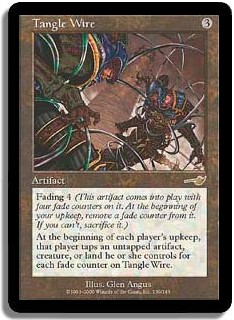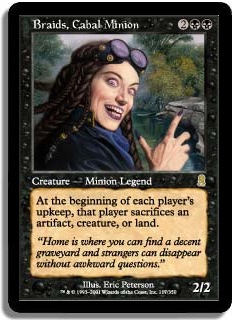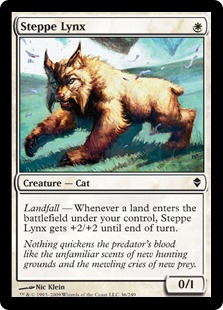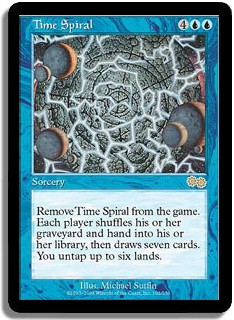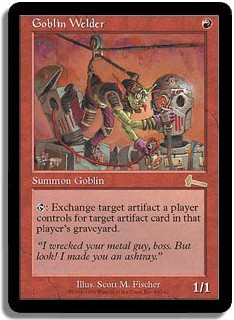Since the introduction of the Magic Online Cube, I’ve seen a lot of discussion about it. Many articles have been written about it (myself included), and we’ve heard a multitude of opinions about the cards in the Magic Online Cube. I’ve heard wildly divergent opinions on the cards in it, and while extremely divergent opinions are common in Magic discussion, I find that it’s especially interesting this time given that the context for people’s opinions is the same since the same cube is being used as the basis of evaluation.
Every once in a while, Magic Online sends out emails talking about cards that people underrate and overrate using the entirety of drafters as a data set. I don’t have anywhere near the amount of data that Magic Online draws those conclusions from, but in this article, I’ll use overall opinions that I’ve seen and heard from people as my data set. A few years ago, I wrote some articles on “hidden gems,” but that was more for cube designers to use in their own cubes, whereas this article will focus more on the drafter’s point of view.
Tangle Wire
Many people are familiar with Tangle Wire because of decks like Vintage Stax and think that because it’s hard to assemble a deck like Stax in Cube that the card isn’t very good in the format. This is a good example of how using outsourcing to other formats as a main method of card evaluation can be a problem because it can lead to restrictive thinking. In this case, people think of Tangle Wire as just a Stax card instead of trying to figure out other uses it can have.
It’s true that in Cube you can’t really assemble a deck like Vintage Stax, but Tangle Wire’s best use in the format is to act as a support card for aggressive decks. It’s a card that I take pretty highly in those decks, especially in decks that don’t have access to a card like Armageddon or Ravages of War, as mana disruption is a great way to prevent the opponent from reaching the later stages of the game and being able to deal with your threats.
It does an excellent job of closing out the game and works extremely well in aggressive decks with a lot of equipment to tap (since tapped equipment still works the same) or ways to generate tokens. But it doesn’t require you to have ways to break the symmetry, as it does that anyway because of the trick where you can get the better end of the deal by stacking the triggers so that Tangle Wire’s “remove a counter” trigger resolves before the “tap your cards” trigger resolves. Of course, if you can get it out with a piece of equipment, it’s definitely better though.
I find that people underrate it because it can be an awkward topdeck late in the game, and, granted, on something like turn 7 it can be. But it’s more realistic to look at it as being cast earlier and doing a very good job of closing out the game with disruption once you’ve gotten a few guys on board. It’s a bit more reliant on being cast in the early stages of the game, but it’s still very good in the middle game as well, especially if the opponent is reliant on big mana finishers or mass removal to win.
Mox Diamond
I find that Mox Diamond doesn’t get taken late, but I think that it should be taken much higher than it presently is, especially since the Magic Online Cube is unpowered and there aren’t many “mana rocks” (like Signets, which are excluded from the cube). I believe that part of the problem is that people tend to overestimate the drawback of discarding land, but I don’t think it’s as bad as people think it is.
I’ve used it successfully in both aggressive and control decks, but I think it’s better in aggressive decks since, at least in this cube, the aggressive mana fixing is pretty light. (I forgot to mention in my prior article that I think that the cube could use an aggressive-leaning mana fixing land cycle, like the Ice Age “painlands” or the Shadowmoor/Eventide “filter lands.”)Â Â Â
It’s a solid early pick since it goes into just about every deck (I tend to take it highly in person but online I can rely on being able to wheel it, which shouldn’t be the case), especially in decks that can take advantage of the extra mana and don’t mind the loss of the card by either not really caring about the card advantage loss or being able to mitigate it through other card advantage mechanisms (like a turn 2 Jace Beleren). All in all, I feel that because of the disparity between its power level and its perceived quality, this may be the most underrated card in the Magic Online Cube.
Braids, Cabal Minion
Braids is another card that I find tends to go later much more often than it should and that people tend to use it far less often than they should. I find that people inexperienced with it tend to go for the “safe play” of just using it with token generation, and while that is a good use for it, it isn’t reliant on token generation to be good. Much like Tangle Wire, it’s very good at locking an opponent out of the game when you’re ahead since the opponent suffers first, like with Tangle Wire. (You were expecting to get to four mana to Wrath my board? Good luck getting to four mana with an active Braids on board!)
While I mentioned how outsourcing to other formats can lead to incorrect evaluations, it’s worth noting that she got banned as a Commander because of her being so oppressive on turn 4. You obviously can’t rely on getting her with the consistency that you can with her as a general, but we can still take away how useful she is as a disruptive card.
There are also a lot of ways to break its symmetry as mentioned earlier—cards like Gravecrawler, Geralf’s Messenger, Kitchen Finks, Bloodghast, cards that have “expired” (Sphere of the Sun and Tangle without counters), and the aforementioned token generators like Spectral Procession and Bitterblossom. Thankfully, a lot of these are very good in aggressive decks with black as a main color.
Steppe Lynx and Wild Nacatl
Both Steppe Lynx and Wild Nacatl get underrated for the same reason that other cards tend to get underrated in cube: people usually have preconceived notions about these cards. In the case of both of these creatures, the notion is as consistently attacking 4/5s and 3/3s, respectively. The problem is that while people get disappointed when these creatures don’t live up to those stats, they tend to forget that even when they’re not as good as they are in a format like Modern, they’re still extremely good. For example, I’ve had people ask me how many fetchlands are necessary to make Steppe Lynx good, and I always instantly respond with zero, as it’s very good as just a 2/3 attacker which it spends most of the time being (and, of course, if you have ways of turning it into a 4/5 via fetchlands, that’s even better!).
With Wild Nacatl, there is the argument that people don’t like green aggro in the Magic Online Cube, but even still, I find that Wild Nacatl tends to get underrated by people playing with the cube online. Much like with Tangle Wire, in the case of Wild Nacatl, people get disappointed when Wild Nacatl isn’t a 3/3. And since getting a three-color aggro deck can be very hard to achieve in the Magic Online Cube, people dismiss Wild Nacatl, but that’s not really the issue here.
Sure, it’s at its best as a 3/3, but it’s definitely solid when it’s doing an impression of Isamaru, Hound of Konda, which it usually does. (I find that even in my own cube, which has more mana fixing, I play Wild Nacatl much more often in decks where its maximum size is 2/2 rather than 3/3.) In an archetype (aggro) where you want to get efficient cheap creatures into play to reduce the opponent’s life total ASAP, it’s important to not underestimate these role-players, even if they’re only attacking for two.
Time Spiral
Time Spiral is a card like Tangle Wire where people look to other formats and don’t focus on how the card can be powerful in Cube. With Time Spiral, people think of it mainly in terms of combo decks like High Tide as a draw seven to get other combo pieces. I’m by no means suggesting that you take Time Spiral so that you can force Storm. Instead, you should think of it as a powerful blue card that has a home in many blue decks in the Magic Online Cube.
Blue decks in the online cube tend to either be control decks or tempo decks, and, thankfully, Time Spiral works well with those archetypes. I find that people tend to not use Time Spiral as often as they should since they get scared of the fact that the opponent gets a full grip of cards as well. However, Time Spiral works well by letting you untap lands, which lets you be the first player able to utilize the freshly drawn cards. In control and tempo decks decks, it lets you untap, usually with either a card advantage mechanic/win condition (control) or a cheap threat (tempo), so the drawback of letting your opponent draw seven isn’t really that bad.
Goblin Welder
I would have talked about Tibalt, the Fiend-Blooded, but I already talked about him in my last article. And since Justin Parnell talked about Reckless Charge in his article about cards to add to your cube, I won’t discuss that either, even though I feel that both of those cards are very underrated in the Magic Online Cube. Instead, I’ll talk about Goblin Welder!
The Magic Online Cube has a good amount of cards that don’t go into every deck. Cards like Entomb, Relic of Progenitus, and Wildfire are examples of this, and it’s one of the things that I like about the cube. Goblin Welder is an example of a card that doesn’t go into every deck (but when it is in the right deck, it works extremely well), but it doesn’t necessarily require being built around either, which I think people assume is the case.
Goblin Welder is an example of a card which best utilizes artifacts with a big impact. The best are the kinds that have ways for the Welder to exchange the card in and out of play, like Precursor Golem, Wurmcoil Engine, and Myr Battlesphere. It also works as a very solid way to protect those large artifact creatures (weld out a Mind Stone / Everflowing Chalice to recur your Triskelion, assuming they put it in the Magic Online Cube on the next update!). It further works well to protect and reuse other artifacts with a big effect that end up in the graveyard as part of their use, like Mindslaver, Nevinyrral’s Disk, and Oblivion Stone. It can also be used to recur things that have expired like Sphere of the Suns, a Tangle Wire without counters, or a Smokestack which is ready to die.
I hope that this article has given you some more information about cards in the Magic Online Cube that you may have underrated and now may see in a new light.
May all of your opening packs contain Sol Rings!
@UsmanTheRad  on Twitter
http://idratherbecubing.wordpress.com – my blog featuring my cube lists.
The Third Power: A Cube podcast featuring myself and Anthony Avitollo!

